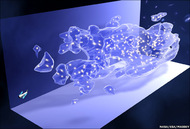
Dark Matter may account for the large-scale structures being mapped by HubbleMy dream job: working at The Perimeter Institute in Waterloo, Ontario. The latest from this "autonomous" center for theoretical physics is a Teaching tool for Dark Matter - a DVD, Teaching guide, and downloadable activities. The 30-minute video is embedded in this post and is definitely worth watching.
Even though there is now some agreement that Dark Matter has been observed (see my earlier post on this topic), there is still much debate about its reality. For an interesting take on matters dark, consider the position of artist/author Anton Sevcik, who, in a private e-mail to me some time ago suggested that
On a really simplistic level, I'm wondering if we've over theorized the subatomic realm, creating too many particles to explain too few things. Just because something is tiny, we seem to presuppose it can only have one property, so we've created a particle for every property. The reason I'm thinking about this is the dark matter myth. I say myth, because dark is a particularly uncomfortable word to anglo saxons, suggesting evil (say, film noir), and anything inexplicable seems by its nature unsettling to our minds.
Sevcik has since expanded on this theme, and I highly recommend The Fallibility of Perception on his View From the Studio blog.
While we're getting all literary here, a web search for Dark Matter poetry yields way too many hits to be a coincidence, and indeed suggests something dark, impenetrable, and slightly creepy, (if not necessarily "evil") at play in the universe. For example, look no further than Musicman's free verse:
I have not come to the
solution of an
illusion or any
delusion to a
solution to the
problem of the cosmic
question which to answer would
create a chasm in the
chaos of the
universe.
The problem with the
problem is the
solution before those who
jump to conclusions not taking
time becomes a
problem with their own
solutions to
conclusions of their own.
(Read the rest of this poem, and rank it here.)
The Perimeter Institute producers don't have these existential qualms: "The module provides teachers with tools to show how dark matter was discovered, to explain why it remains a mystery, and to share the passion of scientists who are trying to discover what it’s made of.”
View the video, and wonder about a universe that can accommodate such weirdness, if dark matter is indeed really out there.